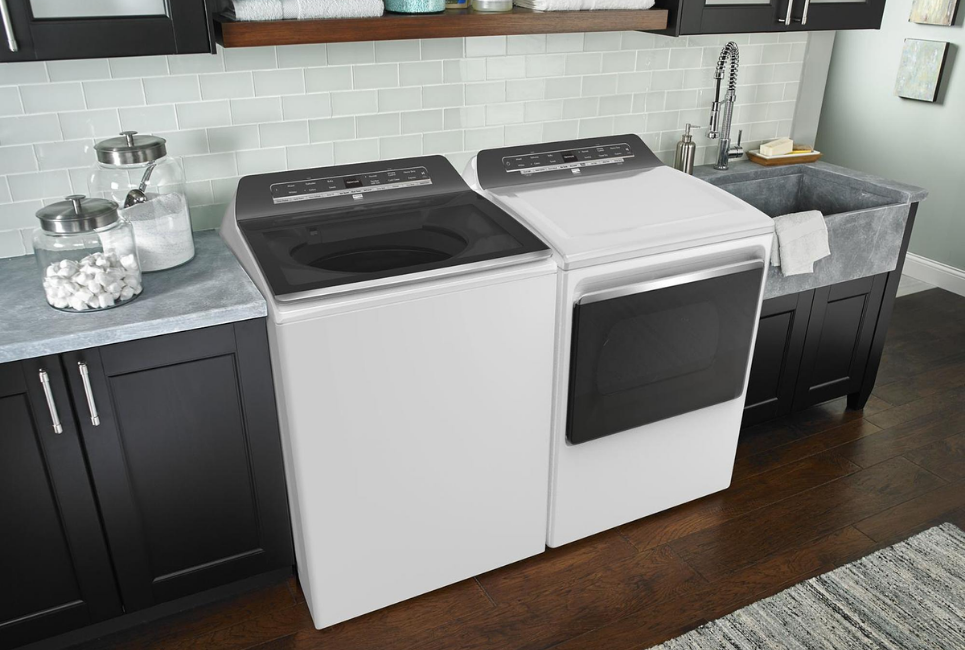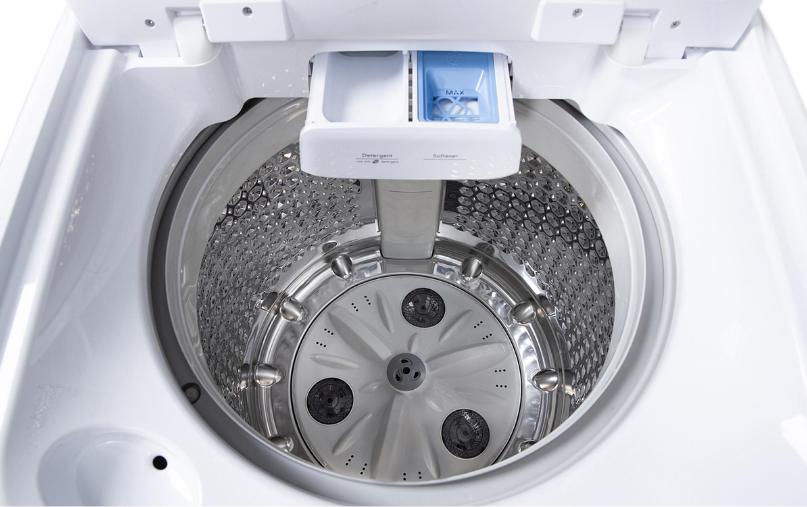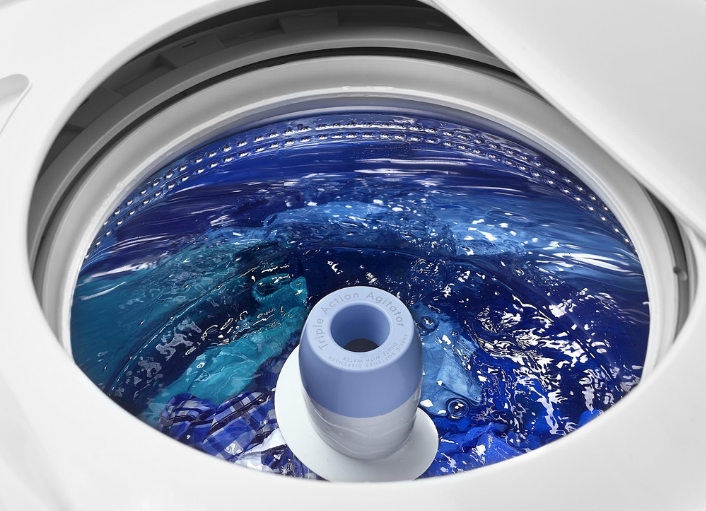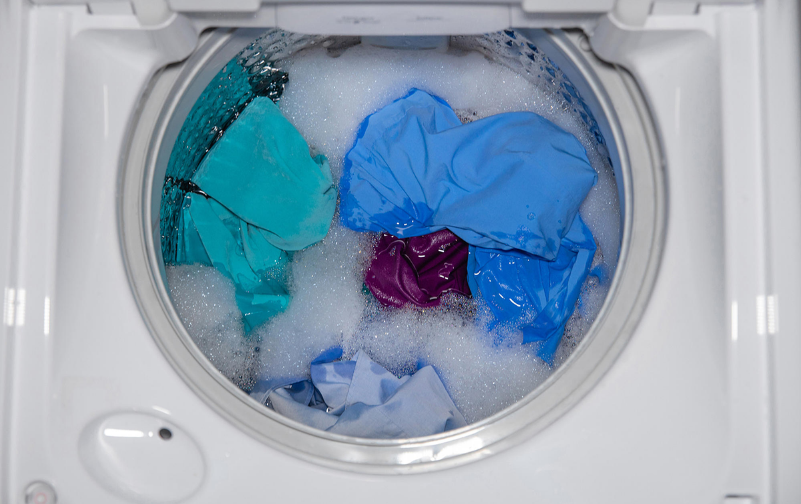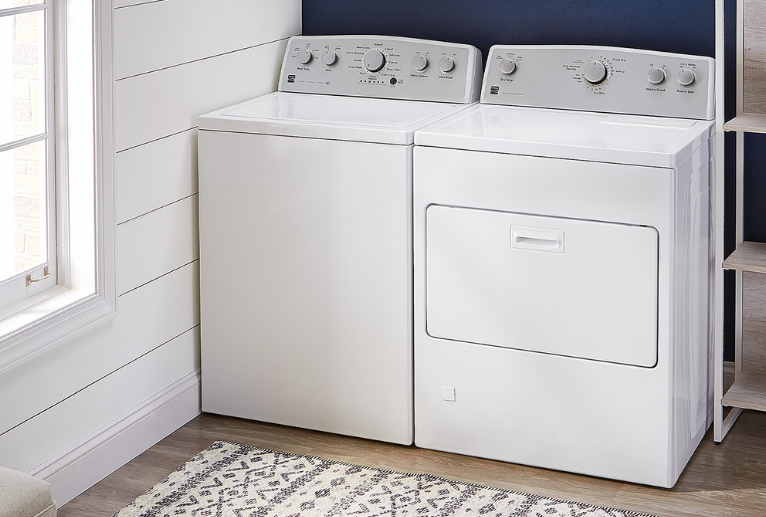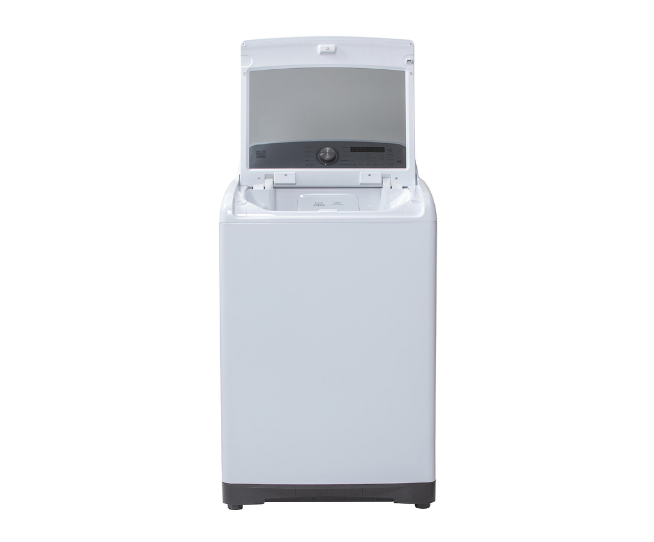- Best Kenmore Stackable Washer and Dryer Combos - November 3, 2022
- Best GE Microwave Filters Guide - November 3, 2022
- Best Kenmore Elite Washers Guide: Which One Is Right For You? - September 1, 2022
It’s easy to take household appliances for granted, but if you neglect to take proper care of them, they will eventually break down. Washing machines are no different; the more you look after them, the longer they’ll last and perform better.
But how do you take proper care of a washing machine? Doesn’t it just, you know, clean itself? If only that were the case! The last thing you probably need right now is another item to add to your house cleaning to-do list, but trust me, if you follow the advice in this Kenmore 80 Series washer care guide, you won’t regret it.
Why I hear you ask? Well, it’s not just that your washer will last for years to come without breaking down; your clothes will also come out cleaner and in better condition, and you won’t have to worry about pesky lint or stubborn mold. Ever. Doesn’t that sound great?
It isn’t as time-consuming to care for your washer as you might think – keep on top of it, and it will feel like hardly any work at all. From using the correct detergent to leaving the door open after a wash, this guide is packed with handy hints and tips. Read on to find out more!
Kenmore 80 Series Washer: An Overview
If you’ve just purchased your first Kenmore 80 Series washer, you should spend some time getting to know its specifications. Being aware of your washer’s drum capacity and electrical requirements is crucial if you’re going to care for it properly.
You’ll be pleased to hear that you’re already in a pretty fortunate position thanks to your choice of washer; Kenmore has been recognized as one of the best appliance brands in America, so you can expect a solid performance from the 80 Series.
In case you aren’t already familiar with this model’s specifications, let’s take a closer look:
- 20 gallon maximum capacity
- 27 inches wide, 38 inches high, 31 ½ inches deep
- Requires 120-volt, 60-Hz, AC only, 15- or 20-ampere fused electrical supply
- 7 temperature settings
- 5 water level settings
- 5 speed settings
- Triple action agitator
- Unified balance system
- Self cleaning lint filter
- QUIET PAK sound insulation
How to use the Kenmore 80 Series Washer
The Kenmore 80 Series washer is a top-load washer that has been around since the ‘90s, and this is a testament to its high quality. Top-load washers have a number of benefits over their front-loading counterparts, not least of which is that they are easier to load. They also:
- Have faster cycle times
- Are more energy efficient when using cold water
- Have a large load capacity
- Allow you to add clothes mid-cycle
However, they also have some drawbacks that you should be aware of before you start using your Kenmore 80 Series. Top-load washers demand a lot more maintenance, they use considerably more water and detergent, and they are usually louder as well.
Here’s how to use your 80 Series to get the best out of it.
Loading
You should always take the time to sort your laundry before putting it into the washer. Fasten up all zippers to make sure they don’t snag on other items, remove any other items that could cause damage, such as pins and belts, then empty all pockets and turn them inside out.
Wash dark colors separately from light colors and heavily soiled items separately from lightly soiled items. Pay careful attention to your washer’s maximum capacity; overloading it can cause damage, and your clothes will not come out of the wash clean.
To avoid water damage, it’s worth finding a good quality washer pan.
Adding detergent
The Kenmore 80 Series washer is built to perform efficiently, and as such, it requires high-efficiency detergent to function properly. I can’t stress this enough when I say this is one detail you should never overlook. Not all laundry detergent was made equal!
In fact, there is an important difference between regular and high-efficiency detergent – namely; the latter is low-sudsing. This is important because too many suds can significantly lengthen the wash cycle, which, in turn, can damage the pump over time.
With the 80 Series, you simply add the correct amount of detergent straight into the washer basket before you put any clothes in.
Starting your washer
After you have followed the above steps, you need to:
- Close the washer lid
- Select the water level based on the size of the load
- Set the water temperature
- Push the Cycle Selector Control in and move it to the right. Select a cycle and time based on the fabrics in the load
- Pull the Cycle Selector Control out. The dial will rotate as the cycle progresses.
Selecting water temperature
Here are some recommended temperatures for different types of loads.
HOT 111°F
- Work clothes
- Sturdy whites
- Diapers
WARM 90-110°F
- Dark/non-colorfast colors
- Permanent press items
- Nylon, polyester, acrylics, silks, wool
- Knits/delicate fabrics
COLD 70-90°F
- Extra sensitive colors
- Non-colorfast items
- Hand washable
Setting your Cycle Selector Control
- For sturdy or heavily soiled loads, use SUPER
- For moderately soiled loads, use REGULAR
- For delicate or lightly soiled loads, use SHORT
Know your machine’s noises
With a top-load washer like the Kenmore 80 Series, you can expect to hear lots of different noises when the machine is in use. Familiarizing yourself with these sounds and what causes them can save you a lot of worry in the long run.
Clicking
At the beginning of a cycle, you will usually hear a click when the door locks in place. However, if the clicking continues while the washer is spinning clothes, you might have left a sharp or hard object inside your load which is hitting against the machine.
Silence
Silence happens when clothes are soaking.
Whirring or humming
The agitator in your 80 Series may make a whirring or humming noise when it interacts with clothes. You may also hear these kinds of noises when the machine is slowing down.
Check your machine has been installed correctly.
Follow these steps to check the installation of your washer:
- Make sure the machine is on an even surface, so all four corners of the base are flat against the floor
- Make sure the hot and cold water hoses are properly connected and have been attached to the correct valves
- Keep your washer and dryer far apart, so they don’t ever touch when in use
It’s also a good idea to invest in a high quality washing machine pan to protect your floor from water damage.
How to Clean Your Kenmore 80 Series Washer
Considering their purpose is to clean clothes and other laundry items, washing machines can actually get pretty dirty themselves. This is something that a lot of people don’t realize.
When dirt and mold build up in your machine, your clothes stop coming out of the wash clean, and you lose that wonderful freshness of just-washed laundry. Instead, items can start to smell, and the problem will only get worse the longer it’s left unsolved.
Washers that aren’t regularly cleaned will break down much faster than those that are well-maintained. Fortunately, cleaning your 80 Series doesn’t have to be back-breaking work. It’s actually pretty easy as long as you stay on top of it.
Here’s how to take good care of yours.
Clean the drum
Fortunately, the Kenmore 80 Series is a top-load washer, so there are no pesky detergent drawers to wash – those can get really slimy over time, yuck! That’s one less job to add to your list.
Since there is no drawer, however, it’s especially important to wash the drum of your machine. There’s no need to reach inside yourself; simply use a washing machine cleaner tablet and run a cycle without any clothes.
The 80 Series is a top load washer, so it’s important to run an additional rinse and spin cycle when the first cycle ends.
Afterward, leave the door open for at least half an hour, so the inside of the drum has time to dry. You don’t want to give mold the chance to grow! If you don’t have washing machine cleaner tablets or you’d rather use bleach, mix one cup of chlorine bleach with two cups of detergent and run the washer through a complete cycle using hot water.
Clean the door
This is another area where top-load washers come out on top compared to front-load washers: the door doesn’t get anywhere near as dirty. Nevertheless, it’s still crucial that you regularly clean it. Clean both the inside and outside of the door with a damp cloth, making sure you pay close attention to the seal and any nooks or crannies where dirt might hide. You can use an all-purpose cleaner if you wish.
Clean the exterior
Use a soft, damp cloth or sponge to wipe up any detergent spills as they occur. Wiping the exterior of your washer once a week will help to keep it looking new.
Water inlet hoses
The water inlet hoses should be replaced every five years to reduce the risk of failure. Make sure you mark the date of when they were last replaced on the label with a permanent marker.
Common Kenmore 80 Series Problems & How to Solve Them
Washer Leaks
| POSSIBLE CAUSE | SOLUTION |
| Household plumbing is leaking | Fix plumbing |
| Inlet hoses are not tight | Tighten hoses according to installation instructions |
| Inlet hose washers are not properly sealed. | Reseat washers according to installation instructions |
| The drain hose is not properly clamped. | Clamp drain hose according to installation instructions |
| Drain is clogged | Remove drain clogs |
| Tub moved forward during unloading | Ensure tub is centered before starting load |
| Load is unbalanced | Redistribute the load |
| Washer is overloaded | Reduce load size |
Won’t drain/won’t spin wet loads
| POSSIBLE CAUSE | SOLUTION |
| The drain hose is kinked or clogged | Straighten or unplug hose |
| Correct operation of the neutral drain | The washer will drain without spinning after a wash or rinse |
| Lid is open | Close the lid |
| The drain hose is more than 96 inches above the floor | Lower drain hose |
| Too much detergent | Use less detergent |
| Wrong cycle for the load | Choose a cycle with a higher spin |
| Low voltage or using extension cord | Check electrical source |
| Cold rinses | Cold rinses leave loads wetter than warm rinses |
Cycle stuck
| POSSIBLE CAUSE | SOLUTION |
| Drain hose less than 39 inches above the floor | Raise drain hose |
| Drain hose fits tightly into standpipe | Adjust drain hose for a loose fit |
| Drain hose taped into the standpipe | Do not seal with tape |
Won’t fill/won’t rinse/won’t agitate
| POSSIBLE CAUSE | SOLUTION |
| Water inlet valve screens are plugged | Clean screens |
| Hot and cold hoses are reversed | Reverse hoses |
| The Inlet hose is kinked | Straighten hose |
| Timer dial is not lined up | Turn the timer knob to the right slightly and pull |
Ten Kenmore 80 Series Washer Maintenance Tips
Follow this advice to ensure your washer is always working at its best.
#1 – Always use high-efficiency detergent
You should never compromise when it comes to detergent. If you fail to use HE detergent, you risk putting your machine under unnecessary strain, which will eventually cause damage.
HE detergent is readily available in most supermarket stores, so you shouldn’t have any trouble getting hold of it. Trust me; your 80 Series will thank you for it!
#2 – Leave the lid open after use
Most of us probably close the lid of our washers without thinking after we’ve finished using them – after all, that seems like the natural thing to do.
However, did you know that closing the lid straight after use can actually cause bacteria and mold to grow inside your washer? This is because the interior stays damp for longer, providing an ideal environment for mold to develop.
Leave the lid open for half an hour after running a cycle to allow your washer to dry.
#3 – Clean the exterior
Nobody wants a washing machine that looks dirty and outdated. If you wipe the outside of your machine with a damp cloth once a week, then this prevents dirt and spillages from building up.
#4 – Clean the filter
The filter plays a crucial role in collecting lint and other unwanted by-products, so it’s a good idea to clean it once a month to make sure it can still function optimally.
If you fail to do so, lint will build up inside the machine and cover your clean clothes.
#5 – Deep clean your machine
Doing a deep clean might sound like a lot of effort, but actually, it’s pretty easy! All you have to do is put a washing machine cleaner tablet in the drum and run a cycle. I’d recommend doing this once every couple of months.
#6 – Load your washer correctly
Pay close attention to the maximum capacity of your washer, and make sure you never exceed it. It might seem annoying if you have a big load of laundry that needs doing, but throwing it all in at once will probably result in your clothes still coming out dirty.
Plus, overloading your washer puts additional strain on it, which can quickly cause damage.
#7 – Check the hoses
Over time, hoses can become corroded and may need replacing. You should check them regularly for signs of wear and tear and to make sure they are attached correctly.
Hoses should always allow a steady flow of water that doesn’t meet any resistance from twists or kinks.
#8 – Never leave damp laundry in the machine
Doing so will encourage bacteria and mold to grow rapidly. Remove any items as soon as the cycle is complete to prevent them from being affected by mold, mildew, and bad odors.
#9 – Balance your laundry
Particularly when it comes to top-load washers like the 80 Series, it’s important to place laundry items in the machine evenly, spacing them out around the agitator, which sits at the bottom of the tub. This will ensure your dirty laundry comes out consistently clean.
#10 – Run a hot cycle
You should aim to run a hot cycle at least once a week to keep your machine relatively clean between deep cleans.
FAQs
Question: How often should I clean my Kenmore 80 Series washer?
Answer: A good rule of thumb is to perform a quick basic clean once a week, wiping down the exterior and door and running a hot cycle, then perform a deep clean once a month which involves:
• Using bleach or a washing machine cleaner tablet
• Wiping the inside and door with a damp cloth and disinfectant/all-purpose cleaning spray
• Checking and cleaning the lint filter if necessary
Question: Where is the lint filter in my Kenmore 80 series?
Answer: The lint filter, or lint trap, is located under the agitator. This is the case with most top-load washers. To reach it, twist off the top of the agitator and pull the filter from beneath.
Question: Where do I put fabric softener in my Kenmore 80 Series washer?
Answer: The fabric softener dispenser in your washer is located on top of the agitator. Occasionally it will need cleaning, in which case you should remove the dispenser cup and soak it in hot water.


